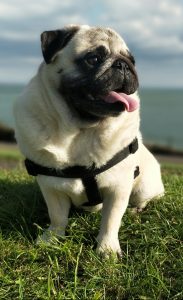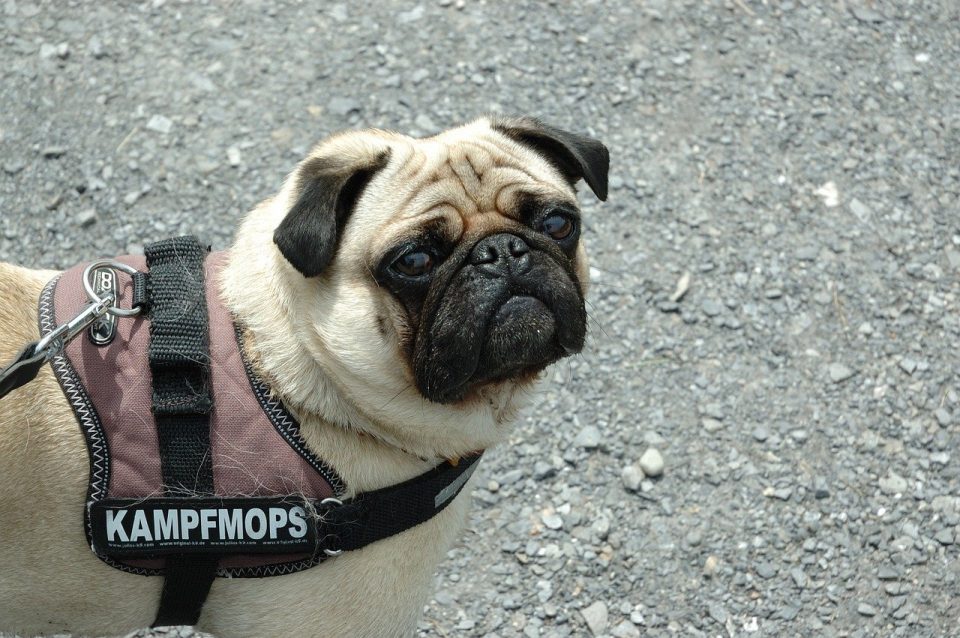The question “Is a Pug a Bulldog?” comes up more often than you may think.
My friend has a Bulldog – or so I thought, until she told me he is a Pug. So, I thought I should find out the differences between the two breeds.
My name is Valerie and my furry friend is Bentley, who is a Clumberdoodle. Bentley likes all other dogs and is particularly kind and gentle with smaller dogs like my friend’s pooch.
I’ve been a little confused about the difference between a Pug and a Bulldog so have done some research and see that there are several major differences between the two breeds.
So let’s look into the question, is a Pug a Bulldog?
Is a Pug a Bulldog?
To put it bluntly, no, a Pug isn’t a Bulldog. Pugs and Bulldogs are different breeds of dogs.
Although Pugs and Bulldogs are different breeds, it’s not unusual to mix up both breeds.
Both breeds have adorable faces, all wrinkly and flat-nosed. This is the feature that makes them so famous. They are just the cutest pus to look at!
Pugs are well-known for their incredibly curly tails. The Pug breed originated in China many centuries ago.
One myth of why their faces are so wrinkled is that the Chinese were trying to start a breed with face wrinkles that spelled out the characters for ‘prince.’
Believe this if you like but even if it is true, they still have the cutest wrinkled faces around!
Bulldogs are also a breed which is loved by many people. Cocky and determined is the character of these little furballs.
It is the personality that is so hard to resist. Not only that, they make the funniest sounds, in fact they are always making noises, whether it is farting, burping or snorting. They are funny dogs to be around.
Bulldogs can trace their parentage back to around the 13th century. Originally the large breed bulldog was taught to fight bulls.
These days they are smaller and classed as companion dogs, although they can weigh up to 50 pounds. Quite amazing considering that they are a small breed.
Typical Pug colours include black, fawn, silver fawn, and apricot fawn. Their eyes are huge relative to their bodies, adding to their list of comical features and Pugs are smaller than Bulldogs.
Pugs vs Bulldogs: Which is Bigger?
Pugs can weigh up to 20 pounds while a Bulldog can easily weigh up to 50 pounds. They are quite close in height although the average Bulldog is larger in the chest area and at least twice as heavy as a Pug.
A male Pug should weigh about 13 – 20 pounds and stand 12-14 inches high while a Bulldog will weigh about 50 pounds and stand 12-15 inches high.
Bulldogs are far stockier than Pugs and even though they are small, can still buckle the knees of an unsuspecting person if they knock into them.
Pugs vs Bulldogs: How do They Behave?
 Pugs are far more active than Bulldogs, who are more relaxed and laid back.
Pugs are far more active than Bulldogs, who are more relaxed and laid back.
Neither breed requires much exercise although Pugs are livelier than Bulldogs. Many people consider Bulldogs to be one of the lazier breeds.
Both are friendly and gentle, sociable creatures, and both make great guard dogs.
You will find that Pups simply love showing off, they love attention and will go out of their way to get it. They are people pleasers and love their humans.
Pugs are very adaptable and will go along with their owner’s routine whether it is watching a movie on the couch or pottering about the house.
Bulldogs are also eager to please. They are very easy-going dogs and the pups are very energetic. They do mellow with age and would really prefer to sit on the sofa with you than go for a walk in the park.
Bulldogs form very strong bonds with their humans and are loyal and protective. They are not known for barking, where the Pug is often a yappy dog so training may be needed there.
Both breeds can be very stubborn and hard to train, with Pugs being harder to housebreak than Bulldogs.
Both breeds enjoy company and do not like to be left alone for long periods of time. If they are left alone, they tend to become destructive and develop behavioural issues.
Pugs vs Bulldogs Lifespan: What’s Their Life Expectancy
Pugs live longer than Bulldogs. They will live to between 12 and 15 years while the average Bulldog lives between 8 – 12 years. Of course, this is dependant on health care, diet and lifestyle.
Pugs vs Bulldogs: Are They Prone to Health Conditions
Because of the flat face, both breeds suffer from a condition known as brachycephalic airway syndrome. This puts them at risk of heat stroke.
Another condition that both breeds suffer from is patellar luxation which affects the knee joints and makes them pop in and out of place.
Because of the flat faces both breeds are prone to dental issues such as dental crowding and periodontal disease.
Both breeds may be susceptible to hip dysplasia and because of the protruding eyes in the Pug you may find them suffering from corneal ulceration and dry eyes.
Bulldogs suffer more health issues than most other breeds of dog. You can expect eye problems as well as breathing disorders. They may also suffer from heart defects and skin problems.
Both breeds are prone to over heating and can suffer from bloat.
For both breeds to stay healthy they need to have their weight monitored and should not be overfed.
Both breeds are sensitive to anaesthesia so if you need to visit the vet for any surgery, make sure that you choose one who is familiar with the breed.
Pugs vs Bulldogs: What do They Look Like?
Both breeds are short and stocky with flat faces and short coats, which are normally shiny and smooth.
Both breeds have large heads and undershot jaws while the Bulldog has a prominent dewlip.
The Pug’s eyes are larger and more protruding while the eyes of the Bulldog are set deeper.
The Pug has a tail which curls up tightly over the rear end while the Bulldog’s tail may be either straight or curled. Both dogs have short ears.
The Pug has longer legs than the Bulldog, and both breeds have deeply wrinkled faces often called squashed or pushed in faces because that is what they look like.
Pugs vs Bulldogs Shedding: What Kind of Coats do They Have?

Both breeds have short coats that need grooming weekly to remove any dead hair. Apart from a weekly grooming session, neither breed needs any further grooming.
The Pug’s coat can come in black, silver or fawn colours while the Bulldog has a better variety of coat colours.
The Bulldog can come in a coat of brindle, white, cream, fawn or any combination of these colours.
Additionally, they can have markings made up of red brindle, solid white, solid red, fawn or fallow, piebald and any other brindle colours.
A point here for allergy sufferers is that both breeds shed profusely, so if you are allergic to dog hair with all the allergens, then these breeds may not be the best choice for you.
Pugs vs Bulldogs Grooming: How Much do They Require?
Both breeds need regular cleaning of their faces along with a weekly grooming session to remove dead hair.
It is important to spend time cleaning all those wrinkles as it is here that bacteria are likely to breed, and infection will soon follow.
Be advised, they are often unable to give birth naturally, due to their size and shape.
Pugs vs Bulldogs Training: Can They be Trained Easily?
Both Pugs and Bulldogs are classed as intelligent breeds and as such are easy to train.
However – and this is a BIG point – both breeds are stubborn and can have their minds set on doing things their own way.
It is important that training start at an early age and that it is re-enforced daily, otherwise thy will develop the attitude that they oversee the household.
Once you have discovered the right motivation for the breed, they will be more inclined to work with you and learn new commands.
You may have heard that Pugs are not intelligent, but the truth is that they are very smart dogs who can take advantage or poor training and loose boundaries. You need to establish boundaries for them at an early age.
Most Bulldogs will not respond to a strong hand, instead they will work better with food and positive reinforcement.
If you need help training your dog check out this article.
Pugs vs Bulldogs Availability: Are They a Rare Dog Breed?
Neither of the breeds is classed as rare and both are easily available.
You should however only buy your pup from a recognised breeder, where you can see at least one of the parents as well as all the medical records of both parents.
Pugs vs Bulldogs Diet: What do They Eat?
Because of the Pug tendency for allergies, many owners feed them a raw food diet. If you follow this path, then you should choose organic meat products. A grain free diet will also help to control allergies.
Dietary supplements are also a good idea to ensure healthy bones and joints. Fish oil is recommended for the coat and skin as well as for general digestive problems.
Bulldogs often have issues with their weight, and it is important to be kept under control. Because Bulldogs reach their adulthood quickly the food you feed them needs to be nutritional.
You should avoid fillers and preservatives (as with any dog food). A point to note with Bulldogs is that any food which contains wheat will produce gas!
For both breeds whole meats are best. These include chicken, beef, lamb and fish.
Bulldogs also develop food allergies and can become allergic to foods such as milk, corn, cheese and dairy products. Corn should be avoided as this will cause hives on the skin.
Pugs vs Bulldogs Family Dog: Are They Good With Children?

Both breeds make wonderful family pets and both love people and children. These two breeds are happy to be in a family where there are older kids, and both can be trained to be gentle with smaller children.
Both breeds are excellent companion dogs although Pugs are more mischievous than Bulldogs, they are also more active.
Neither breed likes very long walks. Simply looking at their bodies will give you a clue on this! Short legs don’t walk that far, and pug noses can battle to catch their breath.
Pugs are normally fine with other dogs and when socialised correctly Bulldogs will be happy with other animals although they are always more reserved than Pugs.
Some male Bulldogs will be aggressive towards other dogs and will need to be supervised.
Pugs vs Bulldogs Environment: Where are They Best Suited?
Both breeds can adapt to apartment living as they are inherently quiet dogs who do not bark that much. If they do bark, it may be due to boredom or loneliness.
Neither breed likes to be left alone and they may bark because of this. They will also bark at strange noises so make good guard dogs.
Neither breed requires a huge garden to play in and neither need long walks.
Pugs vs English Bulldogs: Exercise Needs
If you want a dog to go for long, energetic hikes with you, then these breeds are not for you.
Neither of them likes to walk too far as their legs get too tired and they may battle to breath. Short gentle walks around the block will suit them very well.
Neither breed should be exercised during the heat of summer as they can have difficulty cooling off and may get heat stroke.
Both breeds will appreciate a walk in the early morning when the day is fresh, and the temperatures are most comfortable.
Pugs vs Bulldogs running costs: Are They Expensive to Look After?
In the UK you can expect to pay between £600 – £1500 for a pug. You should expect about four trips to the vet per year, with two of them being simple check-ups. Routine vaccinations are the same for both breeds.
Bulldog pups vary greatly and can cost you between £2,000 – £3,000 to buy.
If you are offered a Bulldog pup at a vastly reduced rate, you may want to ask more questions. The reason for the high cost of Bulldogs is because of their shape.
It is almost impossible to mate and give birth naturally. Most Bulldogs are artificially inseminated and give birth by Caesarean Section. Even dental work is more expensive than in any other breed.
With both breeds you are advised to take out pet insurance to cover the many incidents that happen to them.
Final Thoughts
 When considering which of these two breeds to be your next furry friend, you should seriously think about the coats involved with them.
When considering which of these two breeds to be your next furry friend, you should seriously think about the coats involved with them.
The Pug is far cheaper than the Bulldog to buy. They also tend to be more active and alert and enjoy playing more than Bulldogs.
On the other hand, Bulldogs are content to be family friends and sit quietly with you, so if you are not that active, this type of dog will suit you very well.
Pugs are smaller, weigh less and live longer than Bulldogs, both are great for apartment living.
Both breeds have the most adorable faces, and both have endearing traits which is why it may be a very difficult decision to make!
